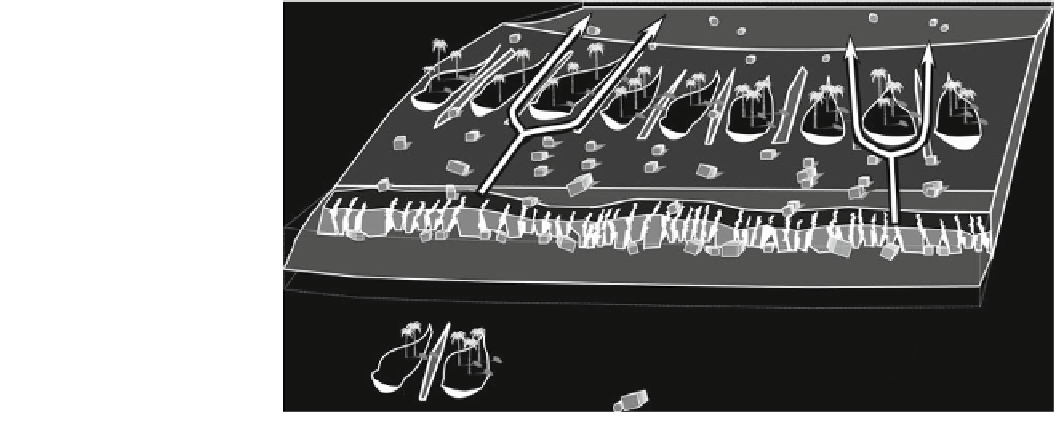Geoscience Reference
In-Depth Information
Fig. 4.6
Model for the impact
of tsunami upon coral atolls in
the South Pacific Ocean. Based
on Bourrouilh-Le Jan and
Talandier (
1985
). Only a
selection of overwash pathways
around mounds (motu) and
through channels (hoa) cutting
across the atoll are marked
Lagoon
Ocean
Reef
edge
Motu
Overwash
pathways
Debris
apron
Coral
boulders
Hoa
continuously in front of motu-hoa topography around the
atoll. More often, changes in the landscape produced by
storms are patchy, whereas motu and hoa form a regular
pattern over considerable distances on many atolls. Motu-
hoa topography can be formed by a single tsunami over-
washing low-lying atolls. Motu or mounds form under
helical flow where opposing vortices meet, while hoa or
channels are excavated where these vortices diverge. The
prominent nature of such topography suggests that mega-
tsunami may be responsible.
Large boulders deposited on atolls are also difficult to
link to storm waves. They have been ripped off the reef
edge and deposited in trains or dumped in piles on the reef
fronting motu. In some cases, isolated boulders have been
carried through hoa and deposited in the backing lagoon
(Fig.
4.6
). This process has not been observed during
storms. While storm waves can erode boulders from the reef
edge, they rarely transport them far. In fact, boulders
wrenched from the reef edge by storms usually end up in a
wedge-shaped apron of talus at the foot of the reef slope.
More unusual is the sheer size of some of the boulders. One
of the best examples occurs on the northwest corner of
Rangiroa Island in the Tuamotu Archipelago (Talandier and
Bourrouilh-Le Jan
1988
). Here, one of the coral boulders
measures 15 m 9 10 m 9 5 m and weighs over 1,400
tonnes. This boulder could have been moved easily by a
tsunami wave 6 m high—Eq. (
3.5
)—but would have
required a storm wave 24 m in height—Eq. (
4.2
). Most
boulders found scattered across atolls consist of coral that is
more than 1500 years old. However, the boulders rest on an
atoll foundation that is as young as 300 years. This fact
suggests that the boulders were deposited by a large tsunami
at the beginning of the 18th century. Local legends in the
South Pacific describe the occurrence of large catastrophic
waves at this time concomitant with the abandonment of
many islands throughout French Polynesia. Significantly,
the legends have the sun shining at the time of the waves—a
fact ruling out tropical cyclones.
The Indian Ocean Tsunami event of December 26, 2004
provided one of the few opportunities to observe the impact
of a large tsunami upon atolls. This event will be described
Indian Ocean, the first wave was 2.5 m high and surged
over every atoll (Kench et al.
2008
). This was followed over
the next 6 h by a succession of 4-5 diminishing waves at
15-140 min intervals. The waves eroded less than four
percent of the islands; however they played a major role in
the redistribution of sediment that normally would have
been produced by the accumulative effects of seasonal
changes in wave climate. Sediment was removed from the
eastern side of atolls fronting the tsunami and either draped
as a layer of sand 10-30 cm thick on top of the atoll or
washed around the sides and deposited in the lee of islands.
Where sediment was voluminous, this leeward deposition
generated a trailing spit across the reef. Erosion at the front
of the atoll left a permanent scarp that in many places
exceeded two meters in height. Nowhere did the waves
erode channels or hoa across the atolls, a fact indicating that
Pacific island motu-hoa topography must be produced by
much higher energy events. Tsunami such as the Indian
Ocean event are not detrimental to atolls, but rather a
contributing factor in vertical island building.
4.4.5
Island Landscapes
Other examples exist in the world where the signatures of
tsunami dominate in preference to those induced by storms.
Surprisingly, these come from places in the Caribbean
Region where all geomorphic landscapes are assumed to be





















